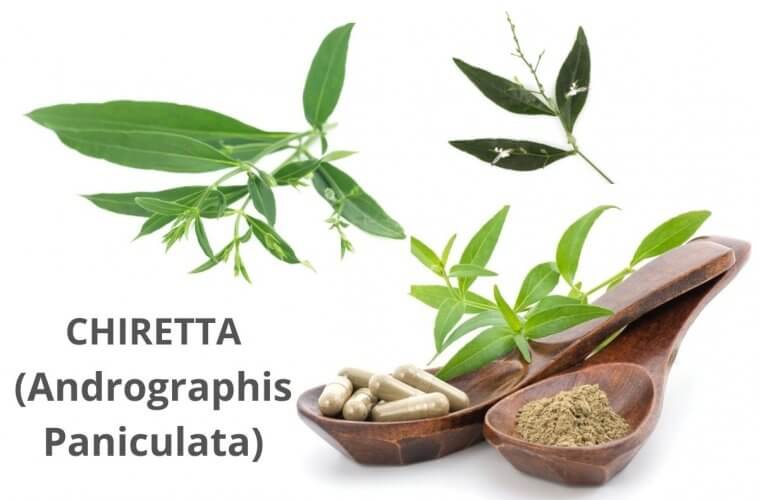Chiretta (Andrographis paniculata) herb has been used for centuries to treat a variety of ailments. It was traditionally used in Ayurvedic medicine and Traditional Chinese Medicine because it’s believed to have anti-inflammatory properties. This article will explore some of the many ways that people can use chiretta (Andrographis paniculata).
Contents
Synonym
Chiretta (Andrographis paniculata) is also known as creat, green chiretta or Chiretta

Habitat
The habitat of CHIRETTA is tropical and sub-tropical forests. This herb has a native range that extends from the Eastern Himalayas to Southeast Asia.
It prefers to grow in moist, shaded areas with plenty of water supply. The plant thrives best in soil that contains lots of organic matter like roots or leaves from other plants.
Description
chiretta grows up to 4-5 feet tall with thin stems covered with leaves attached axially along the entire length on short petioles. They have an aromatic potpourri smell. Its flowers are small and pale yellow, but the flower clusters can be quite large in some species.
Chiretta is an annual herbaceous flowering herb. It has sharp, green leaves and produces white flowers with yellow throats that bloom in the summer months from June to September

Part used
The chiretta (Andrographis paniculata) extract is obtained through distillation of the entire fresh plant, including roots, leaves, and flowers, for maximum efficacy.
The leaves are known for their medicinal properties due to their containing antioxidants, polyphenols, flavonoids, terpenes, etc. That can have many health benefits, such as reducing inflammation or speeding up wound healing rates.

Traditional Uses and Benefits
The name chiretta is derived from the Indian word “chirata,” which means “to check or arrest.” It can be used to stop bleeding and for respiratory tract infections.
It has been traditionally used in Ayurvedic medicine as a remedy for fever, coughs, colds, and lung ailments. Studies have shown that chiretta may also relieve digestive problems such as nausea and vomiting by inhibiting gastric acid secretion through its anti-inflammatory properties.
Studies show that taking chiretta helps support healthy immune system functioning by reducing inflammation, strengthening the overall immune response, and improving white blood cell production, among other things.
Chiretta is traditionally used in India and China by Ayurveda practitioners to treat fevers such as malaria and typhoid fever (both caused by bacteria). It also offers protection against liver disease from toxins, including alcohol abuse which can cause cirrhosis of the liver.
Chiretta can help with cold symptoms, such as sore throat and fever.
It may lower blood sugar levels in people with diabetes. This plant has been shown possible treatment for eczema symptoms such as itching and redness due to its antimicrobial properties.
Traditionally, chiretta is used to treat parasitic worms such as those from the Entamoeba histolytica species and Trichuris trichiura species.
The leaves of Andrographis paniculata are used in the treatment of anemia. It is an excellent tonic for the respiratory tract, digestive system, and blood circulation.
The plant extract of this herb has proven to be an effective anti-cancer agent, with particular efficacy against leukemia.
The natural estrogenic properties of the herb may also serve as prevention for breast cancer and benign prostate hyperplasia.

Chiretta Recipe
-Boil water in a pan.
-Add some salt and oil to the boiling water.
-Put one or two tablespoons of Chiretta powder into the pot (depending on how strong you want it) and stir thoroughly until dissolved.
-Pour your drink into cups for drinking with friends!
Dosage and Precautions
chiretta (Andrographis paniculata) is not recommended for pregnant or lactating women and children under the age of 12. The root should be chewed before swallowing to prevent a bitter taste.
Side effects: Side effects may include nausea and stomach pain.
For adults, the recommended dosage is one 500 mg capsule three times daily.
Some people may be allergic to Andrographis paniculata and experience minor skin irritation or contact dermatitis when using it.
References
- Chiretta facts and health benefits. https://www.healthbenefitstimes.com/chiretta/
- Andrographis paniculata – Wikipedia. https://en.wikipedia.org/wiki/Andrographis_paniculata
- Andrographis: Health Benefits, Side Effects, Uses, Dose …. https://www.rxlist.com/andrographis/supplements.htm
- Pregnenolone: Benefits, Side Effects, Dosage, and Interactions. https://www.verywellmind.com/the-lowdown-on-pregnenolone-89502
- ANDROGRAPHIS: Overview, Uses, Side Effects, Precautions …. https://www.webmd.com/vitamins/ai/ingredientmono-973/andrographis

